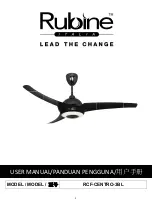
5
To avoid possible fire or shock, follow all
wiring instructions carefully.
Any electrical work not described in these
instructions should be done or approved
by a licensed electrician.
!
WARNING
If your fan is to replace an existing ceiling light
fixture, turn electricity off at the main fuse or
circuit breaker box at this time and remove the
existing light fixture.
Turning off wall switch is not sufficient. To
avoid possible electrical shock, be sure
electricity is turned off at the main fuse or
circuit breaker box before wiring. All
wiring must be in accordance with
National and Local codes and the ceiling
fan must be properly grounded as a pre-
caution against possible electrical shock.
!
WARNING
1.
Remove the fan motor and housing
assembly from the styrofoam packaging
and position it so that the top of the motor
is facing you.
2.
Remove the hanger ball from the downrod
by loosening the setscrew in the hanger ball
until the ball falls freely down the downrod
(Figure 2). Remove the pin from the down-
rod, then remove the hanger ball. Retain
the pin and hanger ball for reinstallation in
Step 8.
PIN
HANGER
BALL
SETSCREW
DOWNROD
Figure 2
How to Assemble Your
Ceiling Fan
3.
Separate, untwist and unkink the three
motor leads. Route the motor leads through
the downrod and seat the downrod in the
motor coupling (Figure 3).
HAIRPIN
CLIP
CLEVIS PIN
SETSCREW (2)
DOWNROD
MOTOR
COUPLING
Figure 3
4.
Align the holes in the downrod with the
holes in the motor coupling. Install the cle-
vis pin and secure with the hairpin clip
(Figure 3). (Pin and clip are supplied in
loose parts bag.) The clevis pin must go
through the holes in the motor coupling
and the holes in the downrod. Push the
straight leg of the hairpin clip through the
hole near the end of the clevis pin until the
curved portion of the hairpin clip snaps
around the clevis pin. The hairpin clip must
be properly installed to prevent the clevis
pin from working loose. Pull on the down-
rod to make sure the clevis pin is properly
installed.
!
WARNING
It is critical that the clevis pin in the motor
coupling is properly installed and the
setscrew securely tightened. Failure to ver-
ify that the pin and setscrew are properly
installed (as shown in Figure 3) could result
in the fan falling.
U.L. Model No.: TB311-1
BP7409-3 COPA BREEZE TB311 9/11/13 1:57 PM Page 5


































